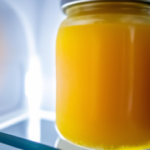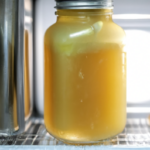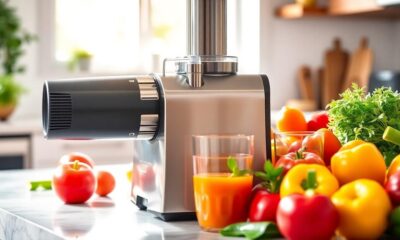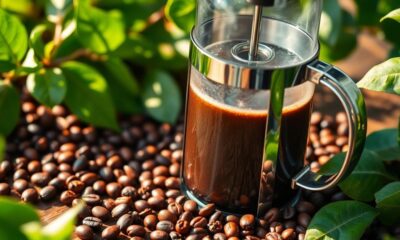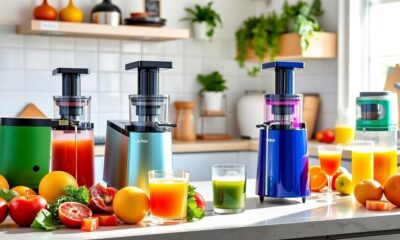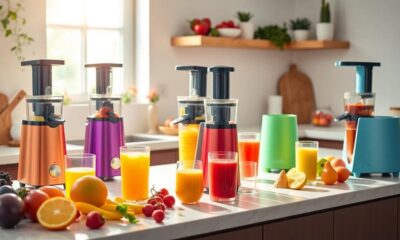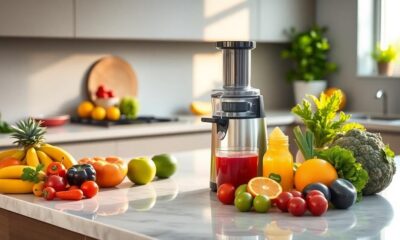Juice Tips and Tricks
How Long Does Ginger Juice Last
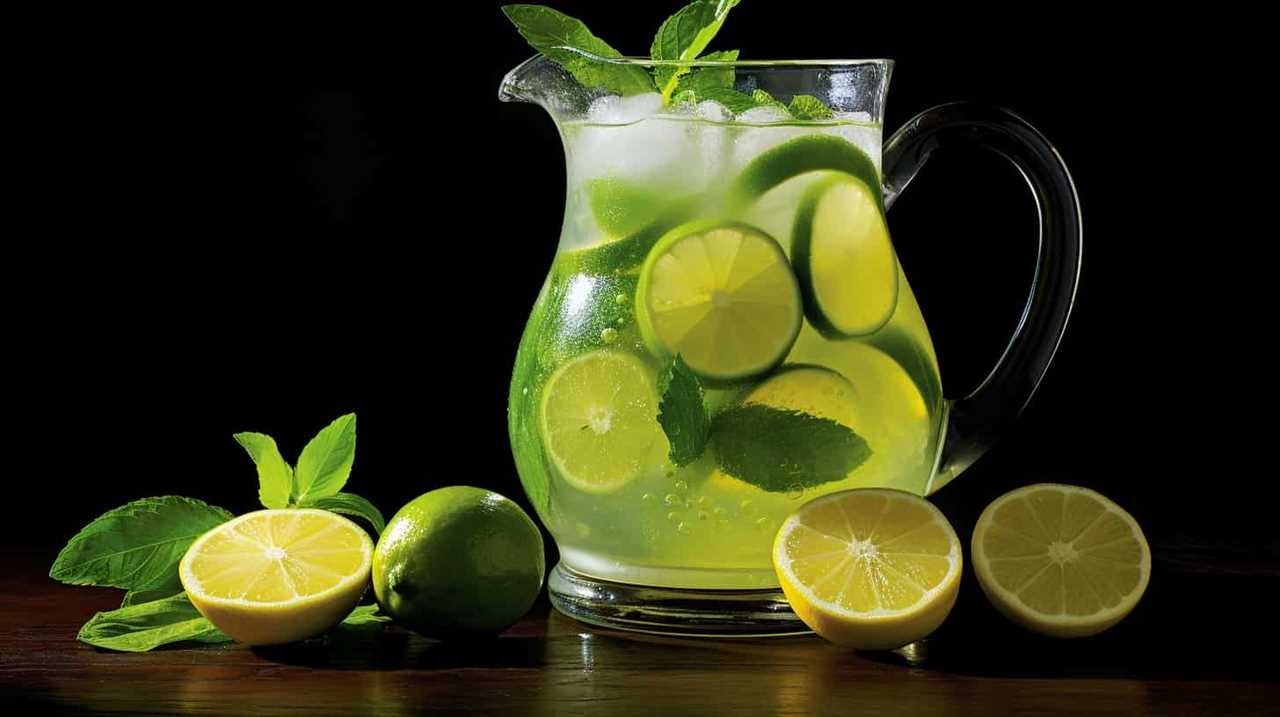

Are you ever wondering about how long that bottle of ginger juice will last in your fridge? Fret no more! We have all the essential information you need.
In this article, we’ll explore the factors that affect the shelf life of ginger juice, the proper storage methods, and how to identify signs of spoilage.
Plus, we’ll share some valuable tips to help you extend the lifespan of your ginger juice. Let’s dive in and serve you the knowledge you deserve!
Key Takeaways
- Proper storage is essential for preserving the shelf life of ginger juice.
- Ginger juice should be stored in airtight containers in the refrigerator to prevent spoilage.
- Signs of spoiled ginger juice include a strong and unpleasant odor, rancid smell, and cloudy appearance.
- Tips for extending the lifespan of ginger juice include storing it in an airtight container, adding lemon or lime juice as a natural preservative, freezing it in ice cube trays, and using it in various recipes.
Factors Affecting Ginger Juice Shelf Life
One of the key factors that affect the shelf life of ginger juice is how it’s stored. Proper storage is essential for shelf life preservation and to ensure that the juice retains its health benefits.
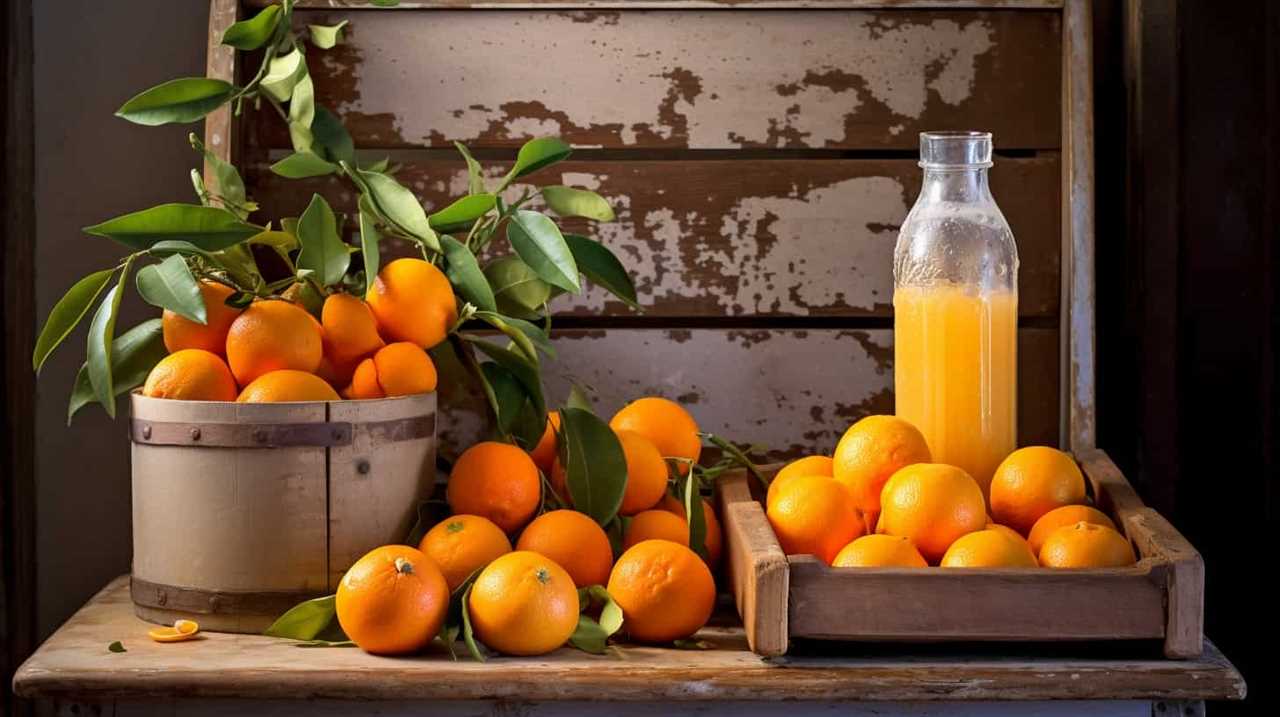
Ginger juice should be stored in airtight containers in the refrigerator to prevent spoilage and maintain its freshness. Exposure to light and air can lead to oxidation and the breakdown of beneficial compounds in the juice.
Additionally, it’s important to use clean utensils and avoid contaminating the juice with other substances.
Proper Storage of Ginger Juice
To properly store ginger juice, we should keep it in airtight containers in the refrigerator. This helps to maintain its freshness and prevent spoilage.
Ginger juice can be extracted using different methods, such as grating fresh ginger and squeezing out the juice, or using a juicer or blender to extract the juice.

Once you have obtained the ginger juice, it’s important to store it correctly to ensure its longevity and preserve its potential health benefits. By storing it in airtight containers, you can prevent oxidation and maintain the flavor and nutritional properties of the ginger juice.
The refrigerator provides a cool and stable environment, which helps to slow down the degradation process and keep the ginger juice fresh for a longer period.
Remember to consume the ginger juice within a week for optimal freshness and quality.
Signs of Spoiled Ginger Juice
When stored improperly or past its expiration date, ginger juice can develop a strong and unpleasant odor, indicating that it has spoiled. Identifying fresh ginger juice is important to ensure that you’re consuming a safe and healthy product.
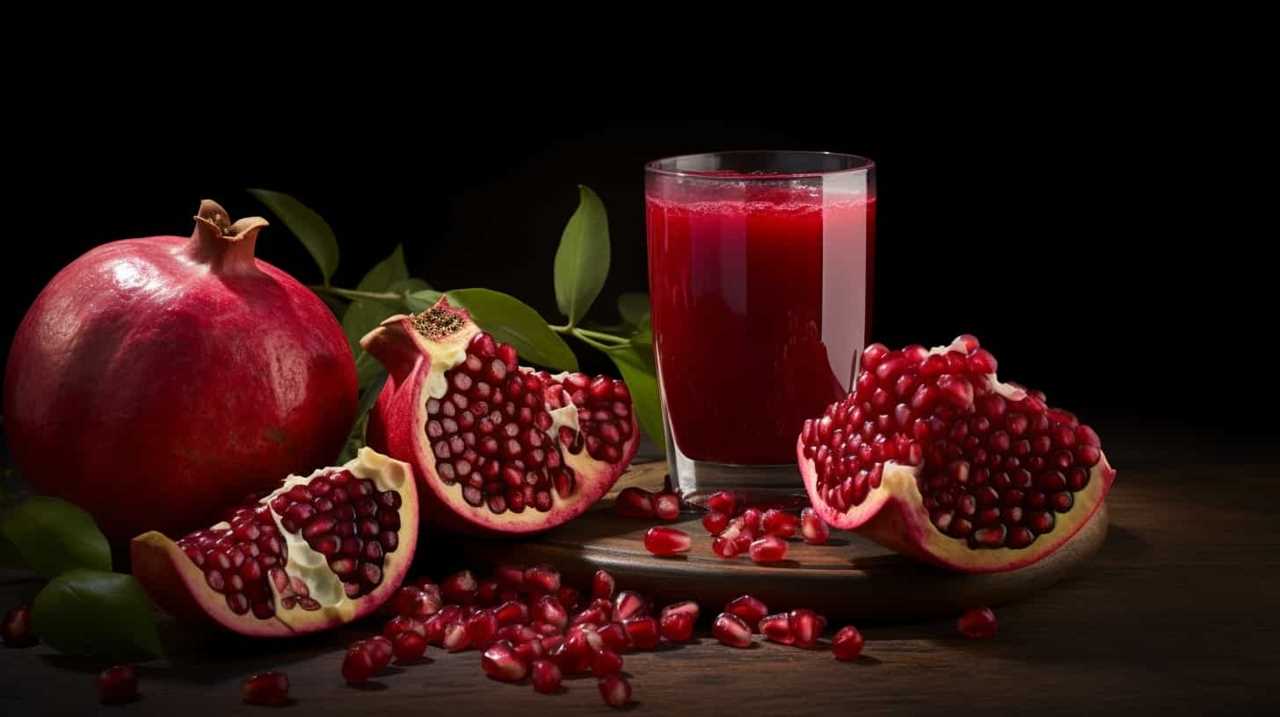
Fresh ginger juice should have a vibrant and spicy aroma, with a slightly sweet undertone. It should also have a bright and golden color, indicating that it’s fresh and full of flavor. Spoiled ginger juice, on the other hand, may have a rancid smell and a darker, cloudy appearance. It’s important to note that consuming spoiled ginger juice can lead to foodborne illnesses, so it’s best to discard any juice that shows signs of spoilage.
In addition to being a delicious and versatile ingredient, ginger juice also offers numerous health benefits. It’s known to aid digestion, reduce inflammation, and boost the immune system. Incorporating ginger juice into your diet can help improve overall health and well-being.
Tips for Extending the Lifespan of Ginger Juice
To ensure that we can enjoy our ginger juice for as long as possible, it’s important to follow these tips and store it properly. One tip is to store ginger juice in an airtight container in the refrigerator. This helps to slow down the oxidation process and prevent the growth of bacteria. Another tip is to add a small amount of lemon or lime juice to the ginger juice, as the citric acid can act as a natural preservative. Additionally, freezing ginger juice in ice cube trays can extend its lifespan for several months.
Aside from extending the lifespan of ginger juice, there are also alternative uses for it. Ginger juice can be used as a marinade for meats or vegetables, adding a flavorful kick to dishes. It can also be used as a base for salad dressings or as an ingredient in smoothies.
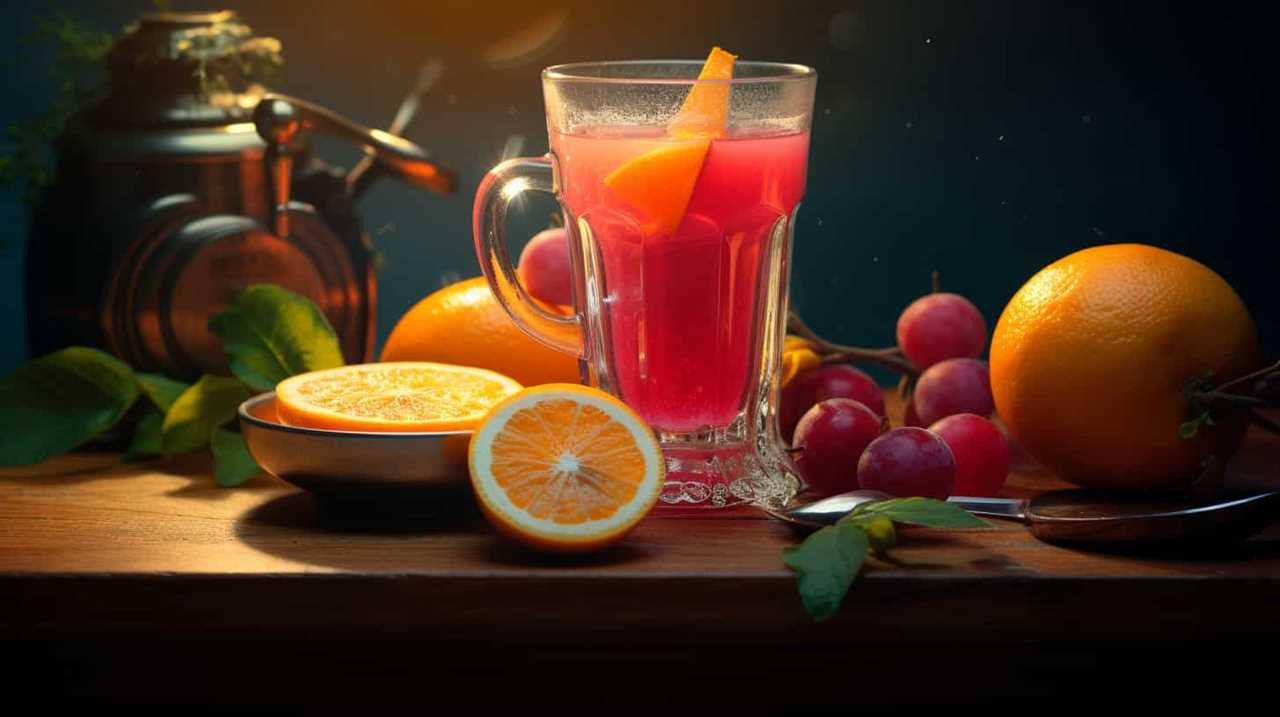
Consuming ginger juice regularly has several benefits. It can help with digestion, reduce nausea, and alleviate inflammation. Ginger juice is also known for its immune-boosting properties and can support overall health and well-being.
How to Use Leftover Ginger Pulp
Our favorite way to use leftover ginger pulp is by incorporating it into homemade ginger cookies. Not only does this prevent waste, but it also adds a delightful flavor and texture to the cookies.
Here are some other creative recipes that make use of ginger pulp:
- Ginger-infused water: Add ginger pulp to a pitcher of cold water and let it steep for a refreshing and detoxifying drink.
- Ginger tea: Boil ginger pulp with water and strain it to make a soothing and aromatic cup of ginger tea.
- Stir-fries and marinades: Use ginger pulp as a flavor enhancer in stir-fries and marinades for a hint of spiciness.
- Smoothies: Blend ginger pulp with your favorite fruits and vegetables for an added health boost.
- Face masks: Mix ginger pulp with honey or yogurt to create a natural face mask that can help improve skin health.
Using leftover ginger pulp not only adds flavor and texture to your dishes but also provides several health benefits, such as reducing inflammation, aiding digestion, and boosting the immune system.
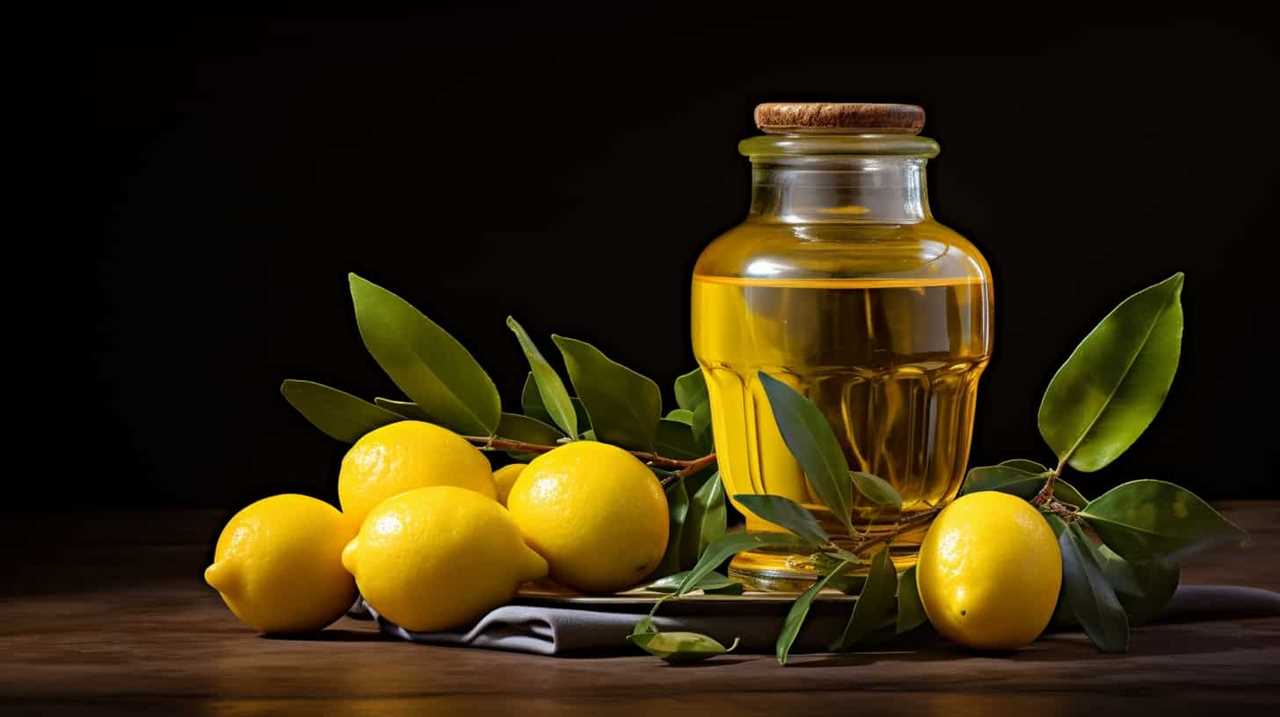
Frequently Asked Questions
Can Ginger Juice Be Frozen for Long-Term Storage?
Yes, ginger juice can be frozen for long-term storage. Freezing ginger juice helps preserve its freshness and extends its shelf life. It is a convenient way to have ginger juice readily available whenever needed.
Can I Use Frozen Ginger Juice Without Thawing It First?
Using frozen ginger juice in recipes is convenient, as it eliminates the need to thaw it first. However, making ginger juice from scratch ensures optimal freshness and flavor.
Can Ginger Juice Be Used in Cooking or Only for Medicinal Purposes?
Ginger juice can be used in cooking and for medicinal purposes. It offers various health benefits, such as aiding digestion and reducing inflammation. Many ginger juice recipes are available to incorporate this versatile ingredient into your meals.
Can I Mix Ginger Juice With Other Juices or Liquids?
Yes, we can mix ginger juice with other juices or liquids. For example, adding ginger juice to orange juice can create a refreshing and healthy beverage. Mixing ginger juice with different flavors can enhance the taste and provide additional health benefits.
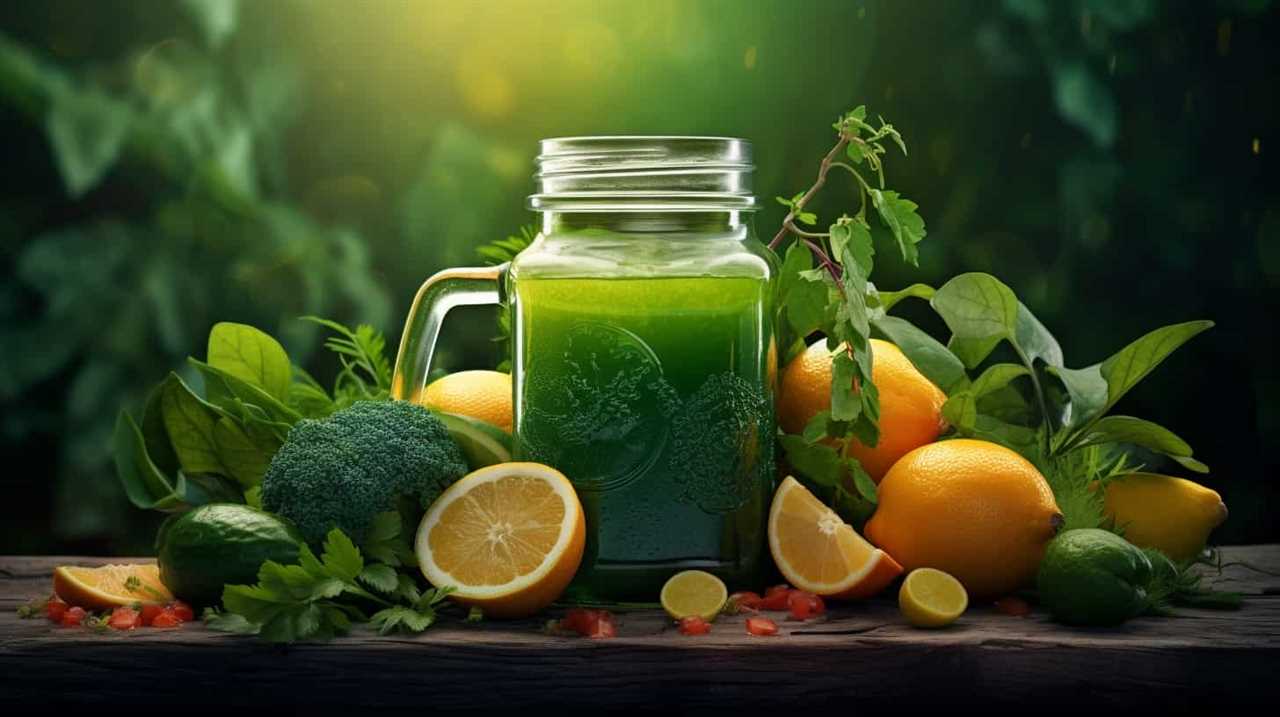
Is It Safe to Consume Ginger Juice That Has Been Left Unrefrigerated for a Few Hours?
It is generally safe to consume ginger juice that has been left unrefrigerated for a few hours. However, to maximize ginger juice benefits and ensure freshness, it is recommended to consume it immediately or store it in the refrigerator. Ginger juice recipes can be found online.
Conclusion
In conclusion, it seems that ginger juice has a surprisingly short lifespan, much like the lifespan of a houseplant in my care. However, with proper storage and a little TLC, you can extend its shelf life and enjoy its health benefits for a bit longer. By keeping it refrigerated in an airtight container, you can preserve its freshness for up to a week. Additionally, freezing ginger juice into ice cubes offers a convenient way to store it for even longer periods, ensuring that none goes to waste. Ultimately, how long ginger juice lasts depends largely on the storage conditions and how soon you plan to use it after preparation. For optimal results, it’s essential to understand **how to store ginger juice** properly to prevent it from spoiling prematurely. In addition to refrigeration and freezing, some suggest adding a small amount of lemon juice or a pinch of salt to act as natural preservatives. By following these simple steps, you can maximize the longevity of your homemade ginger juice while retaining its potent flavor and health benefits.
Remember, when life gives you ginger, make some juice and savor every drop before it turns into a science experiment in your fridge.
Stay fresh, my friends.
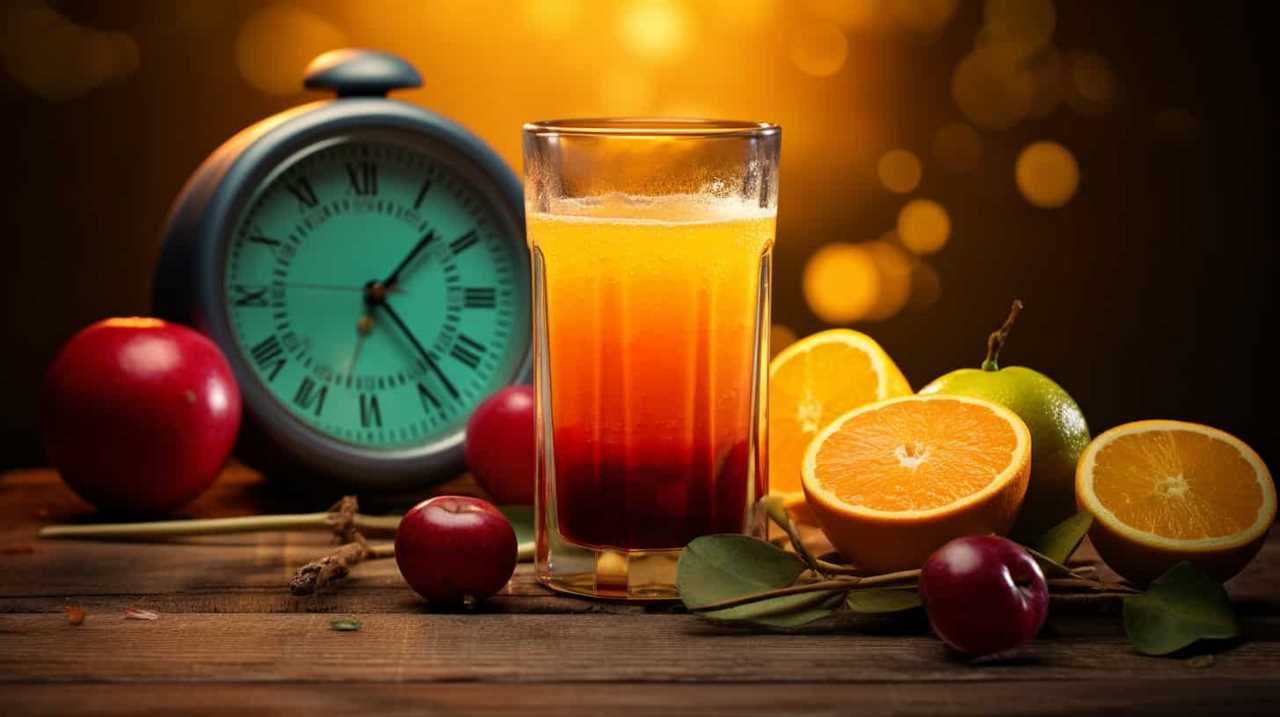
Susannah expertise lies in researching and compiling evidence-based content on juicing, nutrition, and overall health. She is committed to ensuring that The Juicery World offers accurate, up-to-date, and trustworthy information to empower readers to take control of their health. Susannah’s goal is to inspire individuals to embrace juicing as a way to nourish their bodies and live their best lives.
Juice Tips and Tricks
How Much Juice In A Orange

As a fan of starting my day with a revitalizing glass of orange juice, I have always wondered about the amount of juice that can be obtained from a single orange. It is important to note that oranges vary in their juiciness, influenced by different factors that can impact the yield of juice that can be squeezed out.
In this article, I’ll delve into the science behind orange juice content and provide some tips on how to get the most juice out of your oranges.
Firstly, it’s important to understand that the amount of juice in an orange can vary depending on several factors, such as the variety of orange, its ripeness, and the conditions in which it was grown. Additionally, the way you extract the juice can also impact the amount you get.
By exploring these factors, we can gain a deeper understanding of how to get the most juice out of our oranges and make the most out of this delicious fruit.
So, let’s dive in and uncover the secrets of the orange!
Key Takeaways
- Orange juice content varies based on the variety, ripeness, and growing conditions.
- Valencia and blood oranges have higher juice content compared to Navel oranges, which have thicker skin and lower juice content.
- Rolling the orange and using a citrus press or mesh strainer can increase juice yield, with a medium orange yielding 1/3 cup and a large orange yielding up to 1/2 cup.
- Juicing removes some nutrients and fiber, and oranges are a good source of vitamin C, fiber, potassium, folate, and hesperidin, with potential health benefits such as reducing the risk of heart disease and lowering cholesterol levels.
Factors that Affect Juice Content
You’ll want to know what factors affect the juice content of an orange. After all, who wouldn’t want to maximize the juice yield when squeezing fresh oranges for a morning glass of OJ?
Well, one of the primary factors affecting juiciness is the variety of orange. Some varieties, such as Valencia and blood oranges, are known for their high juice content, while others like navel oranges tend to be less juicy.
But it’s not just about the type of orange. Other factors that can impact juice content include the age of the fruit, the region it was grown in, and the amount of rainfall it received during the growing season. For example, oranges grown in dry regions with consistent sunshine tend to have lower juice content than those grown in more temperate, humid climates.
With these factors in mind, it’s important to choose the right type of orange for your juicing needs. Now, let’s explore the different types of oranges and their unique characteristics.
Types of Oranges
The tangy taste of tangerines tantalizes the taste buds. Oranges come in various types, each with unique characteristics, from flavor to size and color. Here are four varieties of oranges that you may encounter in the market, each with its specific cultivation techniques and juice content.
-
Navel Oranges: These are the most common type of orange in the United States. They get their name from the small, navel-like formation on their blossom end. Navel oranges have thicker skin, which makes them easier to peel, and they are seedless. They’re also known for their high juice content, making them an excellent choice for juicing.
-
Valencia Oranges: These oranges are the most commonly grown type worldwide. They have thin skin and are smaller than navel oranges. Valencia oranges are sweet and juicy, and they’re often used for juicing because of their high juice content.
-
Blood Oranges: These oranges are smaller than navel oranges and have a distinctive red color. They get their name from the bright red color of their flesh, which is due to the presence of anthocyanin, a type of antioxidant. Blood oranges have a unique flavor, which is slightly tart. They’re also high in juice content, making them ideal for juicing.
-
Seville Oranges: These oranges are bitter and sour, and they’re rarely eaten fresh. Instead, they’re primarily used for making marmalade and other preserves. Seville oranges have a high pectin content, which makes them ideal for making jams and jellies. They also have high juice content, but their sour flavor makes them less desirable for juicing.
As we’ve seen, different types of oranges have varying characteristics, including their cultivation techniques and juice content.
In the next section, we’ll delve deeper into the juice content of different types of oranges.
Juice Content of Different Types of Oranges
One may be surprised to learn that the juice content of Valencia oranges is higher than that of navel oranges. According to my research, Valencia oranges have an average juice content of 53.5%, while navel oranges have an average juice content of 45.5%. However, it is important to note that the juice content of oranges can vary depending on the specific variety and the juicing technique used. Moreover, the juice content of a navel orange tends to be lower due to its thicker skin and slightly more fibrous texture. In contrast, Valencia oranges are known for their thinner skin and higher pulp-to-rind ratio, which contributes to their superior juiciness. These differences highlight the importance of selecting the right type of orange based on one’s juicing preferences.
To better understand the juice content of different orange varieties, I have created a table below comparing the juice content of Valencia and navel oranges:
| Orange Variety | Juice Content |
|---|---|
| Valencia | 53.5% |
| Navel | 45.5% |
As shown in the table, Valencia oranges have a higher juice content compared to navel oranges. However, this does not necessarily mean that Valencia oranges are always the better choice for juicing. Other factors such as taste preference and availability should also be considered when choosing an orange for juicing.
Moving forward, it is important to consider the best techniques for extracting the most juice from oranges. These tips will be discussed in the next section.
Tips for Getting the Most Juice Out of Oranges
Maximizing the potential of your citrus fruit can be achieved by implementing certain strategies that are known to increase yield. To get the most juice out of an orange, it’s important to use the right orange squeezing techniques.
One effective technique is to roll the orange on a hard surface before squeezing. This helps to break down the membranes inside the fruit, allowing the juice to flow more freely. Another helpful tip is to use your hands to apply pressure evenly on different parts of the orange while squeezing.
Aside from using traditional juicers, there are also alternative methods to extract juice from oranges. For example, using a citrus press can be effective in extracting more juice than simply squeezing the fruit with your hands. Additionally, using a mesh strainer can help to remove any pulp or seeds that may be present in the juice.
By implementing these tips and utilizing different juicer alternatives, you can get the most juice out of your oranges and enjoy the full flavor and nutritional benefits they have to offer.
Moving on to the next section, let’s explore how to calculate the amount of juice in an orange.
How to Calculate the Amount of Juice in an Orange
To accurately measure the liquid content of an orange, it’s helpful to cut the fruit in half and use a juicer or press to extract the liquid.
Calculating juice yield requires measuring the orange size, determining the weight of the fruit, and then extracting the juice to determine the volume of liquid produced.
The amount of juice in an orange can vary depending on the size of the fruit and its ripeness. On average, a medium-sized orange contains approximately 1/3 cup of juice, while a large orange can yield up to 1/2 cup of juice.
By accurately measuring the amount of juice in an orange, you can ensure that you have enough liquid for recipes or for drinking.
Now, let’s explore other uses for oranges.
Other Uses for Oranges
You can do more with oranges than just eating them, like adding a burst of sunshine to your morning smoothie or using the zest to add a zing of flavor to your cooking, like a pinch of salt to a dish.
Oranges are a versatile fruit that can be used in many recipes, from sweet to savory. For example, you can use freshly squeezed orange juice in marinades for meats or seafood, or in salad dressings for a tangy flavor. The zest of an orange can be used to flavor cakes, cookies, and even cocktails.
In addition to their delicious taste and versatility in the kitchen, oranges also provide numerous health benefits. They’re a great source of vitamin C, which is essential for a healthy immune system and can also help with the absorption of iron. Oranges also contain fiber, which can help with digestion and keep you feeling full longer.
So next time you’re in the grocery store, consider picking up a bag of oranges to add some variety to your meals and improve your health.
Did you know that oranges were first cultivated in China over 4,500 years ago? Or that they’re the largest citrus crop in the world? These interesting facts about oranges and more will be explored in the following section.
Interesting Facts About Oranges
I find it fascinating to discuss the historical significance of oranges, as this fruit has played an important role in human history. Oranges have also made their way into popular culture, appearing in movies, songs, and literature.
Additionally, there are many fun facts about oranges. For example, they’re not always orange in color and they can grow on both trees and shrubs.
Historical Significance of Oranges
The humble orange has played a significant role in history, from its origins in Southeast Asia to its widespread cultivation and trade throughout the world. The citrus trade, which began in the 12th century, brought oranges to Europe, where they were initially grown for medicinal purposes. As orange cultivation techniques improved, the fruit became more widely available and was eventually used for culinary purposes.
To understand the impact of oranges, it’s helpful to consider some data. Below is a table showcasing the top orange-producing countries in the world, as of 2020:
| Rank | Country | Production (in metric tons) |
|---|---|---|
| 1 | Brazil | 17,000,000 |
| 2 | China | 12,000,000 |
| 3 | India | 9,500,000 |
The historical significance of oranges is undeniable, but their impact on popular culture is just as noteworthy. Without giving away too much, let’s just say that oranges have found their way into countless songs, films, and TV shows.
Oranges in Popular Culture
From the iconic opening scene of The Godfather to the famous Orange Crush soda commercials, oranges have become a ubiquitous symbol in popular culture.
Oranges have been used in movies and literature to convey a range of emotions and themes, from joy and happiness to death and destruction. In The Godfather, the oranges that fall to the ground foreshadow the impending death of the character played by Marlon Brando. Similarly, in the novel One Hundred Years of Solitude by Gabriel Garcia Marquez, oranges are used as a symbol of love and passion.
Oranges have also been used in advertising, with the Orange Crush soda commercials featuring the slogan ‘Crush it!’ and showing images of oranges being crushed to make the drink. Oranges have also been used as a symbol of health and vitality, with advertisements for orange juice emphasizing the vitamin C content and the health benefits of consuming oranges.
Overall, oranges have become an important part of popular culture and continue to be used in a variety of ways to convey different messages and meanings.
As we move on to the next section about fun facts about oranges, it’s important to note that oranges have played an important role not just in pop culture, but also in history and agriculture. From their origins as a hybrid fruit in Southeast Asia to their widespread cultivation around the world, oranges have a rich and fascinating history.
Fun Facts About Oranges
Did you know that oranges are a great source of nutrition? One medium-sized orange contains about 70mg of vitamin C, which is more than the recommended daily intake for adults. Oranges are also rich in fiber, potassium, and folate, making them a healthy addition to any diet.
Aside from being a great snack, oranges are also versatile in the kitchen. They can be used in a variety of recipes, from salads to desserts. Some popular orange recipes include orange chicken, orange marmalade, and orange sorbet. With their sweet and tangy flavor, oranges can add a burst of freshness to any dish.
Speaking of oranges, there are some common myths about them that are simply not true. For example, some people believe that eating too many oranges can cause heartburn, but in reality, oranges are not acidic enough to cause any discomfort.
In the next section, I will debunk some more myths about oranges.
Common Orange Myths Debunked
You might be surprised to learn that some of the most popular beliefs about oranges are actually myths. For example, thinking that squeezing an orange will give you a glass of juice with the same amount of Vitamin C as eating the whole fruit is not accurate. In fact, the process of juicing removes some of the nutrients and fiber found in oranges.
Additionally, the amount of juice you can get from one orange can vary depending on the size and ripeness of the fruit. On average, one medium-sized orange can yield about 1/3 to 1/2 cup of juice. To further debunk some myths about orange nutrition, here are three surprising health benefits of oranges that you may not know:
- Oranges are a good source of potassium, which can help lower blood pressure.
- Oranges contain hesperidin, a flavonoid that has anti-inflammatory and antioxidant properties.
- Eating oranges may reduce the risk of heart disease, as they are high in fiber and have been shown to lower cholesterol levels.
So, next time you reach for a glass of orange juice, remember that the whole fruit is always the better choice for overall nutrition and health benefits.
Frequently Asked Questions
What is the nutritional value of orange juice?
As a nutritionist, I highly recommend incorporating orange juice into your daily diet due to its numerous benefits. Varieties such as freshly squeezed or fortified with calcium offer essential vitamins and minerals, including vitamin C and potassium.
How long does it take for an orange to produce juice?
Squeezing an orange by hand produces juice in seconds, but commercial juice extraction methods may take longer. Factors such as fruit maturity, temperature, and processing equipment can affect orange juice yield.
Can you use frozen oranges to make juice?
Yes, frozen oranges can be used to make juice. However, the juicing techniques may differ from fresh oranges. It is important to thaw the oranges first and consider the impact on taste and texture.
What is the best way to store oranges to maximize juice content?
To maximize juice content, storing oranges in the refrigerator is best. Rolling them on a hard surface before juicing can also increase yield. Using a citrus juicer is the most efficient technique for extracting juice.
Is it better to hand-squeeze oranges or use a juicer for maximum juice yield?
To achieve maximum yield, juicing oranges is more efficient than hand squeezing. Studies show that juicers can extract up to 20% more juice than manual squeezing, resulting in a higher yield and less waste.
Conclusion
In conclusion, the amount of juice in an orange can vary depending on several factors such as the type of orange, its ripeness, and the method used to extract the juice. Valencia oranges are known to have the highest juice content, while blood oranges have a lower juice content due to their pigmentation. To get the most juice out of an orange, it’s recommended to roll it on a hard surface before squeezing it, and to use a citrus juicer if possible.
Interestingly, oranges have many uses beyond just being a source of juice. They can be used in cooking, as a natural air freshener, and even as a cleaning solution. Oranges are also a great source of vitamin C and other important nutrients.
So next time you enjoy a glass of orange juice or snack on a juicy orange, remember all the hidden benefits and uses of this versatile fruit.
Cindy thoroughly researches juicing trends, techniques, and recipes to provide readers with practical advice and inspiration. Her writing style is accessible, engaging, and designed to make complex concepts easy to understand. Cindy’s dedication to promoting the advantages of juicing shines through her work, empowering readers to make positive changes in their lives through the simple act of juicing.
Juice Tips and Tricks
How Much Lemon Juice Equals The Juice Of One Lemon

As a chef and lover of cooking, I understand the significance of accurately measuring ingredients when preparing a dish. **Lemon juice** can be particularly challenging to measure precisely. The quantity of juice extracted from a lemon may differ depending on factors such as its size, ripeness, and juiciness level. This variability can make it tough to determine the exact amount of lemon juice required for a recipe. To ensure your dish is perfect, it is essential to master the art of measuring lemon juice accurately.
In this article, I will provide information and tips on how to measure lemon juice accurately and how much bottled lemon juice can be used as a substitute for fresh lemon juice. Lemon juice is a versatile ingredient that is used in a variety of dishes, from salad dressings and marinades to desserts and cocktails.
However, using too much or too little lemon juice can significantly impact the flavor and texture of a dish. That’s why it is essential to know how much lemon juice equals the juice of one lemon, whether you are using fresh lemons or bottled juice.
By understanding the measurements and techniques for extracting and using lemon juice, you can ensure that your recipes turn out perfectly every time.
Key Takeaways
- The average juice yield for small, medium, and large lemons is 2, 3, and 4-5 tablespoons, respectively.
- The conversion ratio of 1:1 can be used to substitute bottled lemon juice for fresh lemon juice.
- Bottled lemon juice may have added preservatives and different flavor profile than fresh lemon juice.
- Understanding how much lemon juice equals the juice of one lemon is important for converting lemon juice measurements in recipes.
Importance of Measuring Lemon Juice Accurately in Recipes
Accurately measuring lemon juice in recipes is crucial for achieving the desired flavor profile, so it’s important to know how much juice one lemon yields. The importance of precision cannot be overstated when it comes to cooking and baking.
Too little or too much lemon juice can make or break a dish, so knowing the exact amount required is key. Techniques for measuring accurately include using a citrus juicer, hand-squeezing the lemon, or using a measuring cup.
When using a citrus juicer, make sure to remove any seeds and measure the juice directly into a measuring cup. Hand-squeezing the lemon can also be effective, but be sure to strain the juice to remove any seeds or pulp. And when using a measuring cup, make sure to level off the top to ensure accuracy.
With these techniques in mind, you’ll be able to accurately measure lemon juice in your recipes and achieve the desired flavor profile. Now let’s move onto how to extract lemon juice from fresh lemons.
How to Extract Lemon Juice from Fresh Lemons
You can easily get the tangy and refreshing taste of fresh lemon by following these simple steps. First, wash the lemon thoroughly to remove any dirt or residue.
Then, cut the lemon in half and use a lemon squeezer or juicer to extract the juice. Alternatively, you can also use a fork to press the lemon halves and extract the juice manually.
Using fresh lemon juice has many benefits. It adds a bright and zesty flavor to dishes and can also provide health benefits such as aiding digestion and boosting immunity. Additionally, using fresh lemon juice allows for more control over the amount and intensity of the lemon flavor in a recipe.
Experiment with different methods to extract lemon juice and find the one that works best for you.
When it comes to accurately measuring lemon juice in recipes, it’s important to know how much juice is in one lemon.
How Much Juice is in One Lemon?
I’ve noticed that the amount of juice I can get from a lemon can vary quite a bit depending on many different factors. Some of these factors include the ripeness of the lemon, how much pressure I apply when squeezing it, and even the size of the lemon itself.
In this discussion, I’ll be exploring the average juice yield for different sizes of lemons and the factors that can affect how much juice you can extract from them.
Factors Affecting Juice Yield
Getting the most juice out of a lemon can be affected by various factors, such as the ripeness of the fruit and the method of extraction. Factors affecting extraction are mostly related to the physical properties of lemons. For instance, the amount of pectin in the fruit affects how easily the juice can be extracted. Pectin is a type of fiber that binds the cells together, making it difficult to extract the juice. If a lemon is too ripe, it can also be difficult to extract the juice because the cells have started to break down and lose their structure.
Another factor that affects juice yield is the method of extraction. Hand-squeezing is the most common method of extraction, but it is not the most efficient. Using a citrus squeezer or a juicer can be more effective as they can extract more juice from the fruit. Table 1 below shows the average juice yield for different sizes of lemons using different methods of extraction.
| Lemon Size | Hand-Squeezed | Citrus Squeezer | Juicer |
|---|---|---|---|
| Small | 1 Tbsp | 2 Tbsp | 2.5 Tbsp |
| Medium | 2 Tbsp | 3 Tbsp | 4 Tbsp |
| Large | 3 Tbsp | 4 Tbsp | 5 Tbsp |
Understanding the factors that affect juice yield can help maximize the amount of juice extracted from lemons. However, it is also important to note that the average juice yield for different sizes of lemons can vary. In the next section, we will explore how much lemon juice equals the juice of one lemon.
Average Juice Yield for Different Sizes of Lemons
When picking out lemons, it’s helpful to know the average amount of juice you can expect to get based on the size of the fruit. Juice extraction from lemons is affected by various factors, such as the ripeness, variety, and size of the fruit. Among these, size is one of the most important factors that determine the amount of juice you can extract from a lemon.
On average, a small lemon that weighs around 2 ounces can yield about 2 tablespoons of juice, while a medium-sized lemon that weighs around 3 ounces can yield about 3 tablespoons of juice. A large lemon that weighs around 4 to 5 ounces can yield about 4 to 5 tablespoons of juice.
However, it’s worth noting that juice yield can vary depending on the variety of lemon, as some varieties are more acidic and juicier than others. For instance, Meyer lemons are known for their sweeter and less acidic flavor, but they also have a lower juice yield compared to Eureka or Lisbon lemons.
When it comes to substituting bottled lemon juice for fresh lemon juice, it’s important to keep in mind that bottled lemon juice may have added preservatives and a different flavor profile compared to fresh lemon juice. Nonetheless, if you don’t have access to fresh lemons, you can use bottled lemon juice as a substitute by using a conversion ratio of 1:1.
This means that if a recipe calls for the juice of one fresh lemon, you can use 2 tablespoons of bottled lemon juice instead.
How to Substitute Bottled Lemon Juice for Fresh Lemon Juice
When it comes to substituting bottled lemon juice for fresh lemon juice, there are a few key points to keep in mind. First, there will likely be differences in flavor between the two.
Second, the bottled juice may have a higher or lower acid content than fresh lemon juice.
Finally, it’s important to adjust for concentration, as bottled juice is often more concentrated than fresh juice.
As someone who frequently cooks with lemons, I’ve found it helpful to understand these differences in order to achieve the desired flavor and acidity in my dishes.
Differences in Flavor
You’ll be pleasantly surprised by the subtle variations in flavor that using fresh lemon juice versus bottled lemon juice can bring to your dishes. Fresh lemon juice has a bright, tangy flavor that is hard to replicate with bottled juice. This is because bottled juice is often made from concentrate and contains additives that can alter the taste.
On the other hand, fresh lemon juice contains natural oils and acids that give it a unique and refreshing taste. Aside from flavor variations, using fresh lemon juice also has health benefits. Lemons are a good source of vitamin C and antioxidants, which can boost your immune system and help prevent chronic diseases.
Bottled lemon juice, on the other hand, may contain added sugars or preservatives that can be harmful to your health. That’s why it’s always best to use fresh lemon juice whenever possible. Moving on to the next subtopic, let’s explore the differences in acid content between fresh and bottled lemon juice.
Differences in Acid Content
With fresh lemons, the tartness of the juice is more pronounced than in bottled varieties, providing a zesty kick to your dishes that can’t be beat. This is because fresh lemons are more acidic than bottled lemon juice.
Lemons are considered acidic fruits because they have a low pH level, ranging from 2 to 2.6. The acidity of the fruit is what gives it its tart taste and also plays a role in its health benefits. The high acidity of lemons makes them beneficial for digestion and can help reduce inflammation in the body. Lemon juice is also a good source of vitamin C, which is essential for immune health and skin health.
However, it’s important to note that too much acidity can be harmful to tooth enamel and can exacerbate acid reflux symptoms. When using fresh lemon juice in recipes, it’s important to adjust for the concentration of acid to ensure the right balance of flavors and to avoid any negative health effects.
Adjusting for Concentration
In addition to differences in acid content, another factor to consider when determining how much lemon juice equals the juice of one lemon is concentration. Concentration refers to the amount of a substance, in this case lemon juice, present in a given volume of liquid.
To adjust for concentration, it may be necessary to dilute or concentrate the lemon juice accordingly. This can be done by adding water to dilute the juice or by reducing the water content to concentrate it.
Adjusting for concentration is important not only for accuracy in measuring the amount of lemon juice needed in a recipe, but also for balancing flavors and adjusting for sweetness. By making sure the concentration of lemon juice is correct, the flavor of the dish can be balanced with the other ingredients, ensuring the perfect taste.
Now, let’s move on to the next section and explore how much bottled lemon juice equals the juice of one lemon.
How Much Bottled Lemon Juice Equals the Juice of One Lemon?
If you’re wondering how much bottled lemon juice is equivalent to the juice of one lemon, it’s about two tablespoons.
Using bottled lemon juice can be a convenient and time-saving option, especially when fresh lemons are not available. Additionally, bottled lemon juice typically has a longer shelf life and can be easier to measure out for recipes.
However, it’s important to be aware of the risks of consuming too much bottled lemon juice. Some brands may contain added preservatives or sweeteners that can impact the taste and nutritional value. It’s always best to check the label for any additional ingredients and to use in moderation.
With this in mind, understanding how much bottled lemon juice equals the juice of one lemon can make it easier to convert lemon juice measurements in recipes.
Converting Lemon Juice Measurements in Recipes
Now that we know how much bottled lemon juice equals the juice of one lemon, let’s talk about how to convert lemon juice measurements in recipes. Measuring accuracy is crucial when it comes to recipe consistency, and using the right amount of lemon juice can make or break a dish.
When a recipe calls for the juice of one lemon, it typically means about 2-3 tablespoons of juice. However, this can vary depending on the size and juiciness of the lemon. To ensure accuracy, it’s best to measure the juice using a tablespoon or a measuring cup. If you don’t have a measuring tool, you can estimate that one medium-sized lemon will yield about 2 tablespoons of juice. To maximize the juice content of one lemon, try rolling it on the countertop with gentle pressure before cutting it open, as this helps to release more juice. Additionally, warming the lemon slightly by microwaving it for 10-15 seconds can also increase the juice yield. By following these methods, you can better estimate or measure the juice content of one lemon for your recipe.
Keep in mind that the amount of juice can also vary depending on how you extract it – using a juicer or squeezing by hand can yield different amounts. By paying attention to these details, you can ensure that your recipe turns out just right.
Now that we’ve covered how to measure lemon juice accurately, let’s move on to tips for storing fresh lemon juice.
Tips for Storing Fresh Lemon Juice
When I have leftover fresh lemon juice, I always make sure to store it properly to ensure its freshness.
One option is to refrigerate the lemon juice in an airtight container for up to a week.
Another option is to freeze the juice in ice cube trays and then transfer the frozen cubes to a freezer-safe bag for up to 6 months.
Additionally, you can preserve the lemon juice by adding citric acid and storing it in sterilized jars for longer shelf life.
Refrigeration
Although it may seem like a hassle, refrigerating leftover lemon juice is necessary to prevent it from spoiling quickly and wasting the juice of one lemon. Lemon juice is highly acidic and can go bad or mold quickly if left at room temperature. Therefore, storing it in the fridge is the best way to ensure its freshness and usability.
Furthermore, refrigeration can also help in preventing mold growth in lemon juice. Mold thrives in moist and warm environments, which is why leaving lemon juice out can increase the likelihood of mold growth. By refrigerating the juice, you create a less hospitable environment for mold to grow, which ultimately helps in preserving the juice’s quality and taste. To better understand the benefits of refrigeration, check out the table below that outlines the recommended storage time for fresh lemon juice in the fridge.
| Storage Method | Maximum Shelf Life |
|---|---|
| Refrigeration (in an airtight container) | 2-3 days |
| Freezing (in an airtight container) | 4-6 months |
As you can see, refrigeration is the best option when it comes to storing leftover lemon juice. However, if you’re not planning on using the juice within the next few days, freezing it is another viable option to consider.
Freezing
If you want to extend the shelf life of your leftover lemon juice, you should consider freezing it. Freezing lemon juice is an effective way to preserve its freshness and flavor for a longer period.
Here are some of the uses for frozen lemon juice and the pros and cons of freezing it.
-
Uses for frozen lemon juice:
-
Adding to cocktails or mocktails
-
Using in marinades or salad dressings
-
Making lemonade or sorbet
-
Adding to recipes that call for lemon juice
-
Using in baking recipes
-
Pros of freezing lemon juice:
-
Extends the shelf life of the juice
-
Retains freshness and flavor
-
Convenient to have on hand for recipes
-
Saves time and money
-
Cons of freezing lemon juice:
-
Changes in texture and consistency may occur
-
Freezing may affect the acidity level of the juice
-
May not be as good as fresh lemon juice
Overall, freezing lemon juice is a great way to make sure that you always have lemon juice on hand for your recipes. However, if you want to preserve lemon juice for an even longer period, you can try preserving it with citric acid.
Preserving with Citric Acid
Preserving leftover citrus with citric acid is a great way to extend the life of your fruits and vegetables. Citric acid can help prevent spoilage, inhibit the growth of bacteria and mold, and enhance the flavor and texture of your food.
There are many uses for citric acid in the kitchen, including as a natural preservative, a flavor enhancer, and a cleaning agent. One of the benefits of preserving with lemon juice is that it can be used in a variety of recipes. Lemon juice can be added to salad dressings, marinades, sauces, and baked goods to add a tangy flavor and help preserve the freshness of your ingredients.
It is also a great way to add a burst of flavor to drinks like lemonade or cocktails. Additionally, using bottled lemon juice can be a convenient and cost-effective way to preserve your citrus, especially if you don’t have fresh lemons on hand.
When it comes to using bottled lemon juice, there are a few tips to keep in mind. First, be sure to check the label to ensure that the juice is made from 100% lemon juice and not from concentrate. Additionally, you may need to adjust the amount of bottled lemon juice you use in recipes, as it can be more concentrated than fresh lemon juice.
With these tips in mind, you can easily preserve your citrus and enjoy the many benefits of using lemon juice in your cooking and baking.
Tips for Using Bottled Lemon Juice
Using bottled lemon juice is a convenient option for adding a burst of citrus flavor to your dishes. One of the benefits of bottled lemon juice is that it has a longer shelf life than fresh lemon juice, so you can always have lemon juice on hand without worrying about it going bad.
Additionally, bottled lemon juice is consistent in its acidity level, making it a reliable ingredient for recipes that require a specific pH level. However, it’s important to remember that bottled lemon juice may not have the same flavor profile as fresh lemon juice, as it’s often made from concentrate and may contain added preservatives.
To ensure that you get the best flavor out of your bottled lemon juice, try to use it in recipes that call for a small amount of lemon juice, rather than as a main ingredient. Now, let’s move on to some common mistakes to avoid when measuring lemon juice.
Common Mistakes to Avoid When Measuring Lemon Juice
Now that we’ve learned some tips for using bottled lemon juice, let’s discuss some common mistakes to avoid when measuring lemon juice. As someone who’s made these mistakes before, I can tell you that they can greatly affect the taste of your dish.
First and foremost, be mindful of spills. Lemon juice can easily spill over the rim of your measuring cup or spoon, affecting the accuracy of your measurement. To avoid this, place your measuring cup on a flat surface and pour the juice slowly. Additionally, make sure to wipe the rim of the measuring cup or spoon with a clean towel to remove any excess juice.
Secondly, using a juicer can also affect the accuracy of your measurement. When using a juicer, the pulp and seeds may also be extracted along with the juice, throwing off your measurement. To avoid this, strain the juice through a fine-mesh strainer to remove any excess pulp or seeds.
By following these simple tips, you can ensure that your lemon juice measurements are precise and accurate, resulting in a perfectly balanced dish.
Here are three important things to keep in mind when measuring lemon juice:
-
Be mindful of spills by pouring slowly and wiping the rim of the measuring cup or spoon.
-
Use a fine-mesh strainer when using a juicer to remove any excess pulp or seeds.
-
Always measure lemon juice accurately to ensure a perfectly balanced dish.
Frequently Asked Questions
Can I use lime juice instead of lemon juice in a recipe?
I can substitute lime juice for lemon juice in a recipe. Lime juice has a similar tangy flavor, but with a slightly different taste profile. The benefits of using lime include added vitamin C and a unique twist to the dish.
How long can I store fresh lemon juice in the fridge?
I store fresh lemon juice in the fridge for up to 2 weeks. Its shelf life depends on factors like temperature and level of acidity. Always use smell and taste to confirm freshness before using.
What is the best way to extract lemon juice from a lemon?
I’ll tell you the best way to extract lemon juice from a lemon: just squeeze it. Lemon squeezing techniques are simple, and using fresh lemon juice has benefits like adding flavor and vitamin C to your food.
Can I use lemon concentrate instead of bottled lemon juice in a recipe?
I wouldn’t recommend using lemon concentrate in cooking as it lacks the depth of flavor and nutrients that fresh lemon juice provides. However, using lemon concentrate in cocktails can be an efficient and consistent option.
What is the difference between Meyer lemons and regular lemons when it comes to juicing?
Wow, the difference between Meyer lemons and regular lemons when it comes to juicing is astounding! Meyer lemons have a sweeter, more floral flavor profile, making them perfect for juicing techniques that require a subtle touch. Regular lemons, on the other hand, have a more tart and acidic taste, making them ideal for juicing techniques that require a bold, zesty flavor.
Conclusion
Well, that’s all the information I’ve got on measuring lemon juice accurately in recipes. I hope this article has helped you in your culinary adventures. Remember, whether you’re using fresh lemons or bottled lemon juice, it’s important to measure the juice accurately to ensure the best results. Don’t be afraid to experiment with different amounts of lemon juice in your recipes to find the perfect balance of tartness and sweetness.
In conclusion, always keep a juicer, a strainer, and a measuring cup handy when working with lemons. And if you’re feeling lazy, don’t hesitate to use bottled lemon juice as a substitute for fresh lemon juice. Just remember that not all bottled lemon juice is created equal, so make sure to check the label for the amount of juice per serving.
With these tips and tricks, you’ll be able to add a splash of lemon juice to any recipe like a pro!
Susannah expertise lies in researching and compiling evidence-based content on juicing, nutrition, and overall health. She is committed to ensuring that The Juicery World offers accurate, up-to-date, and trustworthy information to empower readers to take control of their health. Susannah’s goal is to inspire individuals to embrace juicing as a way to nourish their bodies and live their best lives.
Juice Tips and Tricks
How Much Juice In Half Lemon

As an avid cook who enjoys experimenting with new recipes, a frequently asked question when it comes to incorporating lemons into cooking or baking is how much juice can be extracted from half a lemon? I have found that the amount of juice extracted can vary based on a few different factors.
In this article, I will explore the different factors that can affect lemon juice yield, as well as share some tips and techniques for maximizing your lemon juice output.
One of the main factors that can impact how much juice you can get from a lemon is its freshness. A fresher lemon will generally yield more juice than one that is older and has been sitting around for a while. Additionally, the temperature of the lemon can also play a role, as a warmer lemon can release more juice than a colder one.
By understanding these different factors and using the right techniques for extracting lemon juice, you can get the most out of your lemons and add a bright and tangy flavor to your dishes.
Key Takeaways
- The amount of juice yielded from a lemon can be affected by various factors such as freshness, temperature, size, ripeness, and amount of pressure applied during squeezing.
- Hand-held reamer is a better tool for extracting lemon juice than mechanical juicer, while citrus press is the most efficient.
- To maximize juice yield, it is recommended to roll the lemon on a hard surface and give it a gentle massage before juicing.
- Lemon juice can be stored in the refrigerator for 2-3 days or frozen for long-term storage, and can be used in various ways such as marinades, dressings, desserts, and cocktails.
Factors Affecting Lemon Juice Yield
If you’re like me and love adding a little extra lemon juice to your recipes, it’s important to know that factors affecting yield include temperature and the type of juicer used.
For instance, lemons that are at room temperature yield more juice than those that are chilled. Additionally, using a hand-held reamer, which crushes the lemon, will yield more juice than a mechanical juicer, which can leave some juice behind in the pulp.
Another factor affecting yield is the type of lemon used. Some lemon varieties, such as Meyer lemons, are known to be juicier than others. So, if you’re looking for maximum juice yield, it’s worth considering the type of lemon you’re using.
Now that we’ve covered the factors that can affect juice yield, let’s move on to discussing some tools for extracting lemon juice.
Tools for Extracting Lemon Juice
You can easily get some tasty lemonade by using a citrus press to extract the tangy nectar from your citrus fruit. This is one of the most efficient juice extraction techniques, as it maximizes the amount of juice you can get from each lemon. However, if you don’t have a citrus press, don’t worry! There are alternative juicing tools that you can use, such as a reamer, a juicer, or even a fork.
Here is a table comparing the pros and cons of each tool:
| Tool | Pros | Cons |
|---|---|---|
| Citrus press | Efficient, easy to use | Can be expensive |
| Reamer | Inexpensive, easy to find | Can be messy |
| Juicer | Can extract juice from other fruits as well | Can be bulky |
| Fork | No special equipment needed | Not very efficient |
Now that you know about the different tools for extracting lemon juice, let’s move on to the next step: preparing lemons for juicing.
Preparing Lemons for Juicing
Now, let’s get started on prepping those lemons for juicing! Lemon squeezing techniques can vary depending on the type of lemon you’re using.
Some popular varieties for juicing include Meyer lemons, Eureka lemons, and Lisbon lemons. Meyer lemons are known for their sweeter flavor and thinner skin, while Eureka and Lisbon lemons are more tart and have thicker skin.
To prepare your lemons for juicing, start by washing them thoroughly with water to remove any dirt or debris. Next, roll the lemon on a hard surface, such as a countertop, while applying gentle pressure with your hand. This helps to break down the internal membranes and release more juice.
Finally, cut the lemon in half lengthwise and use a citrus juicer or your hands to squeeze the juice out.
Now that we’ve covered how to prepare your lemons for juicing, let’s move on to techniques for maximizing juice yield.
Techniques for Maximizing Juice Yield
To get the most out of your lemons, try giving them a gentle massage before juicing to break down the internal membranes like you would knead dough to activate the yeast. This technique has been shown to increase juice yield by up to 20%.
Another way to maximize juice extraction is to use fresh lemons. The longer a lemon sits on the counter, the more it loses its juice content. It’s best to use a lemon as soon as possible after it’s been picked or purchased.
When it comes to measuring lemon juice, it’s important to keep in mind that the amount of juice can vary depending on the size and ripeness of the lemon. One half of a medium-sized lemon typically yields about 1 tablespoon of juice, but it’s always a good idea to measure to ensure accuracy.
Measuring Lemon Juice
When measuring lemon juice, it’s important to keep in mind that the amount can vary depending on the size and ripeness of the citrus. One common method for measuring lemon juice is to cut the fruit in half and squeeze it using a juicer or by hand. A typical medium-sized lemon can yield around 2 to 3 tablespoons of juice. However, this amount can differ based on the lemon’s ripeness and the amount of pressure applied during the squeezing process.
Alternative methods for measuring lemon juice include using a citrus reamer or a handheld citrus press. These tools can help extract more juice from the fruit compared to using just your hands. It’s also worth noting that different lemons can produce slightly different amounts and flavors of juice. Meyer lemons, for example, tend to be sweeter and less acidic than regular lemons, which can result in a more distinct flavor variation.
After measuring your lemon juice, it’s important to store it properly to maintain its freshness and flavor.
Storing Lemon Juice
When it comes to storing lemon juice, there are a few options to consider. Personally, I prefer to refrigerate my lemon juice in a sealed container to keep it fresh for longer periods of time.
Another option is to freeze the juice in ice cube trays for later use in recipes or drinks.
Additionally, some people choose to preserve their lemon juice with salt or vinegar to extend its shelf life even further.
Refrigeration
Refrigeration can help prolong the shelf life of fresh lemon juice by preventing the growth of bacteria and mold, ensuring that the juice stays fresh for longer periods of time. For optimal preservation, it is recommended to store fresh lemon juice in the refrigerator at a temperature between 35-40°F. This temperature range slows down the growth of microorganisms, which can cause spoilage and affect the quality of the juice.
To illustrate this, check out the table below that outlines the recommended storage times for fresh lemon juice at different temperatures:
| Temperature (°F) | Storage Time |
|---|---|
| 35-40 | 2-3 days |
| Above 40 | 1 day |
| Below 32 | Do not freeze |
Freezing can also be an option for long-term storage of lemon juice, but we’ll explore that in the next section.
Freezing
I hope you’ve found the previous subtopic on refrigeration informative, but if you’re looking for a longer-term storage solution for your lemons, freezing is a great option.
Freezing lemons is an easy and effective way to preserve them for later use. All you need to do is wash and dry the lemons, cut them into slices or wedges, and then store them in a sealed container or freezer bag. You can also freeze the lemon juice in ice cube trays and then transfer the cubes to a freezer bag for future use.
Aside from its preservation benefits, freezing lemons also has creative uses and health benefits. Frozen lemon slices can be used to add a burst of flavor to your drinks, such as water, tea, or cocktails. They can also be used as a garnish for your dishes. Additionally, lemons are packed with vitamin C, which can help boost your immune system and aid in digestion. Frozen lemon juice can also be used in cooking and baking, adding a tangy flavor to your dishes.
Moving on to the next subtopic, preserving lemons with salt or vinegar is another great option for those who want to extend the shelf life of their lemons.
Preserving with Salt or Vinegar
Preserving lemons with salt or vinegar is a simple yet effective way to keep your lemons fresh for a longer period. Both methods involve packing the lemons in a jar with either salt or vinegar, which helps to prevent spoilage and enhance the flavors. Here are a few things to keep in mind when considering salt vs vinegar preservation:
-
Salt preservation: This method involves packing lemons in a jar with salt and allowing them to sit for several weeks until they soften. The salt draws out the lemon juice, creating a salty and tangy liquid that can be used in various recipes.
-
Vinegar preservation: This method involves packing lemons in a jar with vinegar and allowing them to sit for several weeks until they soften. The vinegar infuses the lemons with a tangy sourness that can be used in dressings, marinades, and sauces.
-
Health benefits of lemon juice: Both salt and vinegar preservation methods enhance the health benefits of lemon juice. Lemons are rich in vitamin C and antioxidants, which help to boost immunity and reduce inflammation.
-
Choosing the right method: The choice between salt and vinegar preservation ultimately depends on personal preference and intended use. Salt-preserved lemons have a more intense flavor and are ideal for use in savory dishes, while vinegar-preserved lemons have a milder flavor and are better suited for dressings and marinades.
Preserving lemons is a great way to get the most out of your fruit, but what about the leftover lemon rinds? Stay tuned for some creative ways to use them in the kitchen!
Using Leftover Lemon Rinds
Transform your leftover lemon rinds into a fragrant and zesty addition to your morning tea by steeping them in hot water for a few minutes. Not only does this provide a delicious and refreshing flavor to your tea, but it also offers numerous health benefits. Lemon rinds are rich in antioxidants, which can help boost your immune system and protect against diseases. Additionally, they contain vitamins and minerals that promote healthy skin, aid digestion, and reduce inflammation.
If you’re feeling creative, there are endless possibilities for using leftover lemon rinds beyond steeping them in tea. For instance, you can use them to infuse vinegar or olive oil for a flavorful marinade or salad dressing. You can also add them to your compost pile to provide essential nutrients to your plants. By finding alternative uses for your lemon rinds, you can reduce waste and get the most out of your produce.
Now, let’s move on to some delicious recipes using lemon juice.
Recipes Using Lemon Juice
Get ready to add a zesty kick to your meals with these delicious recipes that use the tangy goodness of lemon! Not only does lemon juice add flavor to your dishes, but it also comes with numerous health benefits.
Lemon juice is rich in vitamin C, which boosts your immune system and helps your body absorb iron. It also contains antioxidants that protect your cells from damage and reduce inflammation.
If you’re out of lemon juice, don’t worry! There are several substitutes you can use, such as lime juice, orange juice, or vinegar. However, if you want to reap the full benefits of lemon juice, it’s best to use the real deal.
Lemon juice can be used in a variety of recipes, from marinades and salad dressings to desserts and cocktails. Some popular dishes include lemon chicken, lemon garlic shrimp, and lemon bars. So, grab a few lemons and start exploring the endless possibilities of this versatile ingredient!
Looking for more citrus fruits to try? Check out the next section for some inspiration!
Other Citrus Fruits to Try
You’ll be missing out on a whole world of vibrant and tangy flavors if you don’t venture beyond the realm of lemons – try adding some grapefruit, blood oranges, or even kumquats to your cooking repertoire!
Each of these alternative citrus options brings its own unique flavor profile to the table, adding depth and complexity to any dish.
-
Grapefruit: This citrus fruit is known for its bitter and tart taste, which pairs well with sweeter ingredients such as honey or sugar. It can also add a refreshing twist to savory dishes like salads or grilled meats.
-
Blood oranges: With its deep red flesh and sweet, slightly bitter taste, the blood orange is a delicious addition to any dish. Try using it in cocktails, desserts, or as a colorful garnish.
-
Kumquats: These small, oval-shaped fruits are tart and tangy, with a sweet peel and sour flesh. They can be eaten whole or sliced thinly and added to salads, sauces, or marinades for a burst of citrus flavor.
By incorporating these alternative citrus options into your cooking, you can add new dimensions to your favorite dishes and discover exciting new flavor combinations. Don’t be afraid to experiment and try new things – you might just find your new favorite ingredient!
Frequently Asked Questions
How many lemons are needed to make a certain amount of juice?
To determine the amount of lemon juice needed for a specific recipe, consider the desired quantity of juice and the juicing technique. Factors such as the size and ripeness of the lemons can also affect the amount of juice produced.
Can I use bottled lemon juice instead of fresh lemon juice?
Wow, nothing beats the tangy punch of fresh lemon juice! Bottled juice can’t compare in taste or health benefits. It’s worth squeezing a few extra lemons to get that zesty flavor in your dish.
How long does it take to juice a lemon by hand?
Juicing a lemon by hand takes about 30 seconds and requires a firm grip and proper technique. Efficiency can be improved by rolling the lemon on a hard surface before juicing. Alternative methods include using a citrus juicer or a reamer.
Can I freeze lemon juice for later use?
Freezing lemon juice is a great way to preserve its freshness and reap the benefits of this versatile citrus fruit. It’s easy to do and convenient for later use in cooking or drinks. Plus, it saves time on juicing fresh lemons.
How do I know if a lemon is ripe enough to yield the most juice?
To ensure the most juice from a lemon, look for one that is fully yellow and slightly soft to the touch. Roll it on a hard surface before juicing. Cut it in half crosswise and use a citrus juicer or hand-held reamer for optimal juicing results.
Conclusion
Well folks, after all that research and experimentation, I can confidently say that the amount of juice in half a lemon is variable. Yes, that’s right, there is no one definitive answer. It depends on factors like the lemon’s size, ripeness, and even the method you use to extract the juice. So, if you’ve ever found yourself wondering, “how much juice in a lemon?”—the answer isn’t as simple as you’d think. In short, the juice yield can range anywhere from a tablespoon to almost a quarter cup per half!
But fear not, for I’ve compiled a list of factors that can affect the yield of lemon juice, as well as techniques for maximizing that yield.
As for me, I’ll be sticking to my trusty lemon squeezer and giving those lemons a good roll before juicing. And if all else fails, I’ll just use the leftover rinds for some fancy cocktail garnishes.
But hey, don’t just take my word for it, go forth and experiment with your own lemons! And who knows, maybe you’ll discover the ultimate lemon juice extraction method and become a citrus hero in your own right.
Cindy thoroughly researches juicing trends, techniques, and recipes to provide readers with practical advice and inspiration. Her writing style is accessible, engaging, and designed to make complex concepts easy to understand. Cindy’s dedication to promoting the advantages of juicing shines through her work, empowering readers to make positive changes in their lives through the simple act of juicing.
-

 Popular Juice Brands1 month ago
Popular Juice Brands1 month ago10 Top-Rated Organic Juice Brands to Try
-

 Popular Juice Brands1 month ago
Popular Juice Brands1 month ago9 Best No-Sugar-Added Popular Juice Brands
-

 Juice Tips and Tricks3 days ago
Juice Tips and Tricks3 days agoHow To Make Homemade Pickle Juice
-

 Health Benefits of Juice3 weeks ago
Health Benefits of Juice3 weeks agoHow Much Bottled Lemon Juice Equals 1 Lemon
-
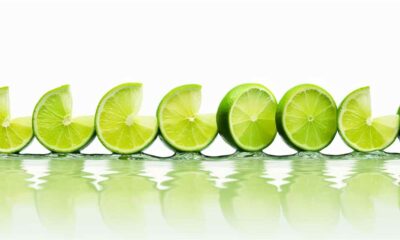
 Vegetable Juices1 month ago
Vegetable Juices1 month ago12 Top Organic Vegetable Juice Brands Reviewed
-

 Juice Tips and Tricks2 weeks ago
Juice Tips and Tricks2 weeks agoHow Long Does Lemon Juice Last After Expiration Date
-
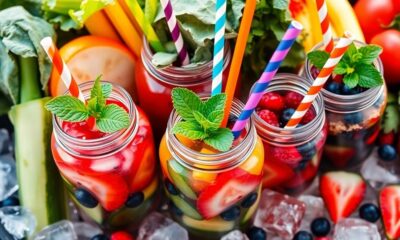
 Vetted3 months ago
Vetted3 months ago15 Best Juices for Diabetics: Refreshing Options That Won’t Spike Your Blood Sugar
-
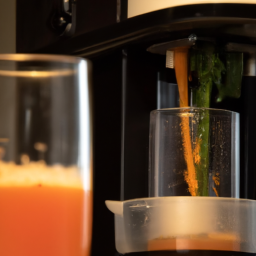
 Juice Tips and Tricks3 weeks ago
Juice Tips and Tricks3 weeks agoHow Long Does Juice Last After Juicing



